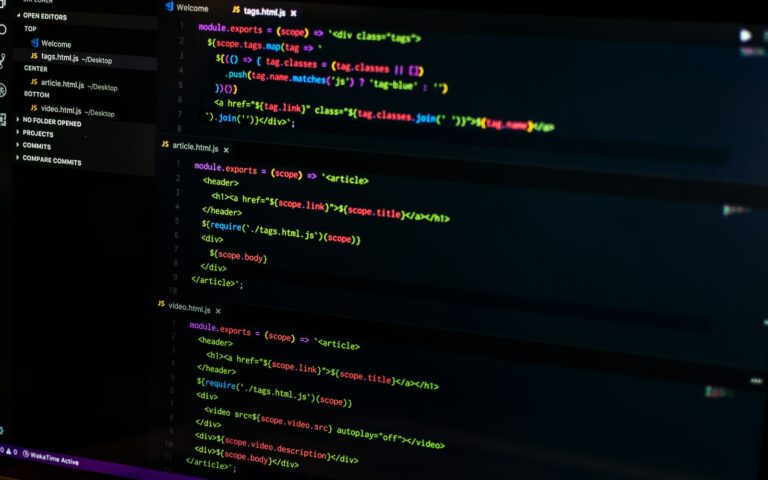Python is a versatile programming language that offers support for object-oriented programming (OOP). OOP is a programming paradigm that provides a modular and reusable way to design software. In this article, we will provide a beginner’s guide to object-oriented programming in Python with a focus on Python classes.
Python classes are the building blocks of OOP in Python. They allow you to encapsulate data and behavior into a single unit. By creating classes, you can define your own data types and customize their behavior through methods and attributes. Understanding classes is essential to becoming proficient in Python programming and OOP in general.
Key Takeaways
- Python supports object-oriented programming.
- Python classes are the building blocks of OOP in Python.
- Classes allow you to encapsulate data and behavior into a single unit.
- Customizing behavior is achieved through methods and attributes.
Understanding Python Classes
If you’re new to object-oriented programming, the concept of classes may seem a bit confusing at first. In Python, a class is essentially a blueprint for creating objects. It defines a set of attributes and methods that the objects will have.
To define a class in Python, you use the class keyword followed by the name of the class, and a colon. For example:
class MyClass:
attribute = 'some value'
def method(self):
return 'some value'
In the above example, we have defined a class called MyClass, with an attribute called attribute and a method called method. Note that the self parameter is always required in Python class methods.
Once you have defined a class, you can create an object (also known as an instance) of that class. To do this, you simply call the class name followed by parentheses:
my_object = MyClass()
Now my_object is an instance of the MyClass class, with the attribute and method defined in the class.
To access the attributes and methods of an object, you use dot notation:
my_object.attribute
my_object.method()
This will return the values of the attribute and the output of the method respectively.
Python Class Examples
Let’s take a look at some practical examples to help you better understand Python classes.
Example 1:
class Dog:
species = 'mammal'
def __init__(self, name, age):
self.name = name
self.age = age
def description(self):
return f"{self.name} is {self.age} years old."
def speak(self, sound):
return f"{self.name} barks {sound}"
In this example, we have defined a Dog class with a class variable called species, and three instance methods called __init__, description, and speak. The __init__ method is a special method in Python that is called when an object is created.
We can create a Dog object and call its methods as follows:
my_dog = Dog('Rufus', 8)
my_dog.description()
my_dog.speak('woof woof')
This will output:
'Rufus is 8 years old.'
'Rufus barks woof woof'
Example 2:
class Rectangle:
def __init__(self, length, width):
self.length = length
self.width = width
def area(self):
return self.length * self.width
In this example, we have defined a Rectangle class with an instance method called area, which calculates the area of the rectangle using its length and width.
We can create a Rectangle object and call its methods as follows:
my_rectangle = Rectangle(5, 10)
my_rectangle.area()
This will output:
50
Python Class Tutorial
Now that you have a basic understanding of Python classes, it’s time to dive deeper into their attributes and methods. In the next section, we will discuss working with class methods and variables.
Working with Class Methods and Variables
In Python, classes can have methods and variables that belong to the class itself, rather than any particular instance of the class. These are known as class methods and class variables, respectively. In this section, we will explore how to work with these features in Python.
Defining Class Methods in Python
To define a class method in Python, you must use the @classmethod decorator before the method definition. This decorator indicates that the method belongs to the class itself, rather than any instance of the class.
Note: The first argument to a class method in Python is always the class itself, conventionally named
cls.
Here’s an example of a class method in Python:
class MyClass:
x = 0
@classmethod
def my_class_method(cls, y):
cls.x += y
In this example, we define a class MyClass and a class method my_class_method. The method takes an argument y, and adds it to the class variable x. Since x belongs to the class, rather than any instance of the class, we can access and modify it from within the class method.
Defining Class Variables in Python
To define a class variable in Python, you simply define the variable within the class, but outside of any method definitions. This variable will then belong to the class itself, rather than any instance of the class.
Here’s an example of a class variable in Python:
class MyClass:
x = 0
In this example, we define a class MyClass with a class variable x. This variable will belong to the class itself, rather than any instance of the class.
Accessing Class Methods and Variables in Python
To access a class method or variable in Python, you can use either the class name or an instance of the class. If you use the class name, the method or variable will belong to the class itself. If you use an instance of the class, the method or variable will belong to that particular instance.
Here’s an example that demonstrates this:
class MyClass:
x = 0
@classmethod
def my_class_method(cls, y):
cls.x += y
my_instance = MyClass()
# Accessing the class method via the class name
MyClass.my_class_method(5)
# Accessing the class method via an instance of the class
my_instance.my_class_method(10)
# Accessing the class variable via the class name
print(MyClass.x)
# Accessing the class variable via an instance of the class
print(my_instance.x)
In this example, we define a class MyClass, an instance of that class my_instance, and a class method my_class_method, along with a class variable x. We then access the class method and variable using both the class name and an instance of the class.
By mastering the concept of class methods and variables in Python, you can enhance your programming skills and leverage the power of OOP in Python.
Inheritance and Polymorphism in Python Classes
Inheritance is a key feature of OOP that allows you to create new classes using existing classes as a foundation. In Python, you can define a derived class that inherits properties and methods from a base class. The derived class can then customize or add to these properties and methods as needed.
To create a derived class in Python, you can use the following syntax:
class DerivedClassName(BaseClassName):
statement(s)
In this syntax, DerivedClassName is the name of the new class you want to create, and BaseClassName is the name of the existing class you want to use as a foundation. The statement(s) block can contain any additional properties or methods you want to add to the derived class.
Polymorphism is another OOP concept that allows you to use a single interface to represent multiple types of objects. In Python, you can achieve polymorphism using classes and inheritance. For example, you can define a base class called Animal with methods like eat and sleep. Then, you can define derived classes like Dog and Cat that inherit from the base class and customize the eat and sleep methods as needed.
To demonstrate inheritance and polymorphism in Python, consider the following example:
class Animal:
def __init__(self, name):
self.name = name
def eat(self):
print(f”{self.name} is eating”)
def sleep(self):
print(f”{self.name} is sleeping”)class Dog(Animal):
def __init__(self, name):
super().__init__(name)
def bark(self):
print(“Woof!”)class Cat(Animal):
def __init__(self, name):
super().__init__(name)
def meow(self):
print(“Meow!”)dog = Dog(“Fido”)
cat = Cat(“Whiskers”)dog.eat()
cat.sleep()dog.bark()
cat.meow()
In this example, we defined two derived classes (Dog and Cat) that inherit from a base class (Animal). We also customized the eat method in the dog object and the sleep method in the cat object. Finally, we used the bark method in the dog object and the meow method in the cat object to demonstrate polymorphism.
Creating and Manipulating Objects with Python Classes
One of the fundamental concepts of object-oriented programming is creating objects. In Python, objects are instances of a class. To create an object, you need to instantiate the class using the constructor method, which by convention is named __init__. Let’s take a look at an example:
class Car:
def __init__(self, make, model, year):
self.make = make
self.model = model
self.year = year
my_car = Car("Ford", "Mustang", 2021)
In this example, we define a class named Car and its constructor method __init__ that takes three parameters, make, model, and year. We then create an object named my_car by calling the Car() constructor and passing in values for the make, model, and year parameters. The object my_car now contains the data for a 2021 Ford Mustang.
Once you have an object, you can access its attributes and methods. Attributes are the properties of an object, and methods are the functions that an object can perform. To access an object’s attribute or method, you use the dot notation. For example:
print(my_car.make)print(my_car.model)
This code will output:
FordMustang
You can also modify an object’s attributes by assignment. For example:
my_car.year = 2022
This code will change the value of the year attribute to 2022 for the my_car object.
Finally, you can delete an object’s attributes using the del keyword. For example:
del my_car.year
This code will delete the year attribute from the my_car object.
Conclusion
Object-oriented programming (OOP) is a powerful tool for Python developers to create efficient, reusable, and scalable code. In this beginner’s guide, we have provided a comprehensive overview of Python classes and OOP concepts.
We began by introducing the basics of OOP and the significance of classes. We then delved deeper into class definition, attributes, and methods. We also provided practical examples to demonstrate the creation of classes in Python.
Next, we explored class methods and variables, including the differences between instance methods and class methods. We explained how to define and access class variables in Python.
We then discussed inheritance and polymorphism, which allow us to create new classes that inherit properties and methods from parent classes. The concept of polymorphism was also explained, along with how it can be implemented using Python classes.
Finally, we guided you through the process of creating and manipulating objects using Python classes. We provided step-by-step instructions on instantiating objects, accessing their attributes and methods, and modifying their properties.
Mastering OOP in Python
By mastering the concepts covered in this article, you can enhance your Python programming skills and leverage the power of OOP. Python classes provide an elegant and efficient way to organize your code, make it more reusable, and improve its overall performance.
With a thorough understanding of Python classes, you can create complex and sophisticated applications that are easier to maintain and extend. We hope this guide has been helpful in getting you started on your journey towards mastering OOP in Python.







